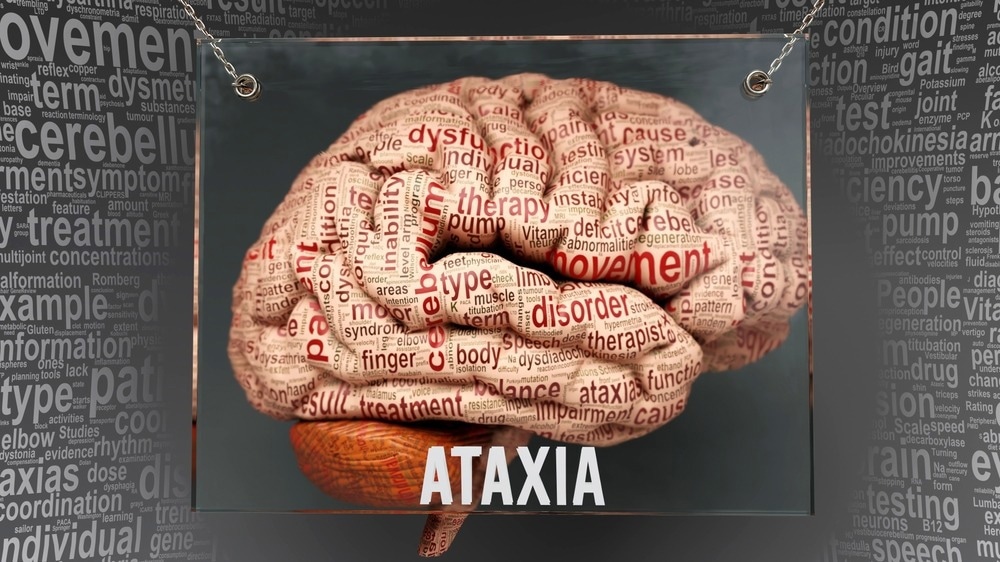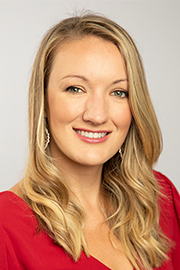I'm Dr. Lauren Moore, NAF's Chief Scientific Officer. I develop our research funding strategy, lead the staff in the research department, and manage NAF's relationship with the Ataxia research community, Ataxia clinicians, and the pharmaceutical industry.
I started my career as a Graduate Research Assistant at the University of Michigan for one of the top Ataxia researchers in the country, Dr. Henry Paulson. I went on to be a Senior Scientist at a pharmaceutical company for several years, where I continued to work towards developing gene silencing therapies for Ataxias. I joined NAF as their Chief Scientific Officer at the beginning of 2022.
My passion for working with ataxia stems from my own family's history of SCA3 (Spinocerebellar Ataxia, Type 3), one of the most common hereditary forms of Ataxia. As a kid, I knew that my grandmother was wheelchair-bound and spoke with jumbled speech, but I just thought it was part of growing old. I didn't realize that she was affected by a hereditary form of Ataxia or that me and my family were at risk for it too. It wasn't until my Dad began to show similar symptoms in his early fifties that I started to ask questions and learn about our family's history with Ataxia.

Image Credit:
At NAF, your vision is to see a world without ataxia. Please could you give an overview of what ataxia is and how it affects individuals?
Generally speaking, "ataxia" refers to clumsiness or a loss of coordination and balance that is not due to muscle weakness. It results from brain or nerve dysfunction and presents symptoms such as stumbling, slurred speech, lack of coordination, and deterioration of fine motor skills.
Damage to different parts of the nervous system can cause ataxia, but in many cases, it is caused by damage to a part of the brain called the cerebellum, which serves as the balance and coordination processing center of the brain. The cerebellum takes sensory information about your body and the environment around you to help you make quick and precise coordinated movements. For example, your cerebellum helps you predict how far a cup is from your hand or how much force your hand needs to exert to grasp it. Damage to the cerebellum may greatly increase the risk of spilling when performing either of these tasks. Individuals with progressive types of Ataxia have increasing difficulties with walking, often leading to the eventual use of assistive equipment like walkers and wheelchairs. You would find way more walkers and wheelchairs at my family reunions than you'd expect to see for my relatives' ages. The cerebellum also helps coordinate eye movements, speech and swallowing, which can greatly impact many more aspects of daily living and lead to early death.
There are over a hundred types of diseases that can lead to ataxia. Unfortunately, with the exception of a few treatable diseases, for most patients, there are no existing drugs to slow or stop the worsening of symptoms over time. There is a huge unmet need in the Ataxia community for developing new effective treatments that can only come with continued progress in ataxia research.
Are there any individuals who are more at risk for ataxia than others?
Yes. Individuals at the greatest risk for ataxia are those with a family history of hereditary Ataxia. For example, because my Dad has a dominantly inherited type of Ataxia, my siblings and I each have a 50/50 chance of also having the disease. Acquired forms of ataxia can be caused by many other neurological conditions, such as head trauma, stroke, or exposure to certain drugs or toxins.
Despite there being currently no cure for ataxia, there are a number of treatments available to help manage its symptoms. Can you describe some of the treatments available?
Sure. Treatment for an acquired form of ataxia involves addressing the underlying cause. Ataxia caused by head trauma, for instance, would require treatment regimens to address the head trauma – usually things like resting physically and mentally to allow the brain to recover or making sure that the trauma didn't result in any bleeding or swelling of the brain.
For hereditary forms of Ataxia, however, the condition typically worsens over time. The goal of treatment is to improve the quality of life and requires a more individualized approach because each person's experience and symptoms are different. Common treatment options include speech and language therapy, occupational therapy, and physical therapy. Some symptomatic treatments also help control tremors and reduce cramping and rigidity.
Recently, the NFL has added ataxia to its concussion protocol. How has this announcement helped to raise awareness surrounding ataxia?
Before the NFL announcement, the word "ataxia" was not well known by people that were not affected or did not know someone who was affected. Now, I see it casually discussed on the news and social media. More public awareness of ataxia and its related symptoms is great for those affected by the rare disease. They'll have an easier time explaining their condition to their friends and family. It will also help others empathize with the daily struggles that Ataxia can cause, impacting every aspect of a person's life.
We hope it may also bring attention and much-needed funding to fuel more investment in Ataxia research and drug development.

Image Credit: Twin Design/Shutterstock.com
Despite its addition to NFL concussion protocols, ataxia still requires further awareness globally. What more should governments and policymakers be doing to help raise awareness of ataxia?
Governments and policymakers can create and support legislation that benefits people affected by rare neurological diseases, such as Ataxia. They can take the time to hear the stories of people in the Ataxia community and understand how the disease affects their life.
Are you hopeful that with continued awareness, funding, and research into ataxia, we will one day see a cure? What would a world without ataxia look like?
I am absolutely hopeful! At the office, we often say that we are working to put ourselves out of business, and it's something that all of us would be happy to do. The outlook for the future has only become more promising during my last decade working in Ataxia research and drug development. I fully expect that trend to continue as our understanding of the disease process for hereditary forms of Ataxia improves. In the past, patients diagnosed with a progressive form of Ataxia were told there is nothing they could do and sent home to "just deal with it."
Now, we have dedicated Ataxia clinics throughout the US and recommended care guidelines to address a person's symptoms as much as possible. There are also numerous pharmaceutical companies actively working on potential therapies for Ataxia. That is not something that could have been said ten years ago.
How can people get involved and help to support the mission of the National Ataxia Foundation?
There are a number of ways you can support NAF's mission of accelerating the development of treatments and a cure while working to improve the lives of those living with Ataxia. The easiest way to get involved is to join as a free member of NAF. We have more than 11,000 members, including patients, family members, researchers, clinicians, nonprofit professionals, and pharmaceutical company professionals. Our members are kept up to date on all the latest news in the Ataxia community. To sign up, go to www.ataxia.org/JoinNAF
To help financially, giving a one-time gift or becoming a monthly donor is a quick and simple way to get involved. Planning a fundraiser in your community or starting a Facebook fundraiser is another way to help with awareness and financial support. More information is available at www.ataxia.org/ways-to-give
What is Ataxia? Learn more about ataxia and inform others.
What is next for you and your work at NAF? Are you involved in any exciting projects?
We have lots of exciting projects right now. You'd have to spend a lot more time with me to learn about all of the programs that we have going on, so I'll just call out a few upcoming events that I'm really excited about.
In a few weeks, we are partnering with the Friedreich's Ataxia Research Alliance and Ataxia UK to host the first International Congress for Ataxia Research. The conference is likely to be one of the largest gatherings of Ataxia researchers and clinicians ever. It will feature over 70 Ataxia-focused presentations, 200+ posters, and a variety of panels and workshops. Featured topics include: gene discovery, imaging, disease mechanisms, cerebellar non-motor circuits and functions, emerging and existing therapeutics, and biomarkers.
In March 2023, we are hosting our 66th Annual Ataxia Conference (AAC). This conference is for patients, their caregivers, and their families. It is geared toward providing updates about drug development progress, sharing helpful information on all aspects of living with Ataxia, and creating community. The world's top Ataxia experts come to present on a variety of topics.
We are also planning an Ataxia Clinical Training (ACT) program for movement disorder fellows. There is a real need for more neurologists with advanced training in the Ataxias. ACT aims to fill this need by bringing early-career doctors together for a two-day intensive education program to acquire practical knowledge about the diagnostic investigation and treatment of the Ataxias.
Where can readers find more information?
About Dr. Lauren Moore
Lauren Moore, PhD has built a reputation as a collaborative and trusted colleague throughout the Ataxia research community. She currently serves as the Chief Scientific Officer at the National Ataxia Foundation. She previously worked for a clinical stage biotech company where she acted as lead scientist over multiple therapeutic programs aimed at developing gene silencing therapies for rare neurological diseases such as Ataxia. She worked as a Graduate Research Assistant in the Rackham Graduate School at the University of Michigan under the mentorship of Dr. Henry Paulson.
Dr. Moore received her PhD in neuroscience from the University of Michigan, where her thesis was titled "Towards understanding and developing antisense oligonucleotide-based therapies for spinocerebellar ataxia type 3." She holds a B.S. in Biomedical Physics from Northeastern University.